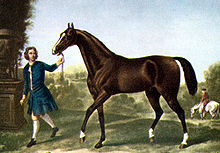
Back دارلي أرابيان Arabic Дарли Арабиан CV Darley Arabian German Darley Arabian Spanish Darley Arabian French Darley Arabian Italian ダーレーアラビアン Japanese Derlija arābu zirgs Latvian/Lettish Дарли Арабиан Russian Darley Arabian Swedish
| Darley Arabian | |
|---|---|
 The Darley Arabian stallion painting by John Wootton | |
| Sex | Stallion |
| Foaled | 1700 |
| Colour | Bay |
| Owner | Thomas Darley |
| Awards | |
| Leading sire in Great Britain and Ireland (1722) | |
The Darley Arabian (c. 1700–1730) was one of three dominant foundation sires of modern Thoroughbred horse racing bloodstock. The other two founders were the Godolphin Arabian and the Byerley Turk. This bay Arabian horse was bought in Aleppo, Syria, by Thomas Darley in 1704 and shipped to Aldby Park in England, as a present for his brother.[1]
One author in 1840 described Darley Arabian's arrival in England during the reign of Queen Anne as the event which "forms the great epoch from which the history of the Turf [as in "turf racing"] should be dated".[2]
There he stood at stud, usually private but sometimes open to outside mares. He was the leading sire in Great Britain and Ireland in 1722. By all accounts, the Darley Arabian stood about 15 hands high and was of substantial beauty and refinement.[3]
The Darley Arabian sired the undefeated Flying Childers. He also sired Bartlett's Childers, an unraced brother of Flying Childers, who was the great-grandsire of the extremely influential Eclipse. The Darley Arabian was to become the most important sire in the history of the English Thoroughbred.[3] His son Bulle Rock was the first Thoroughbred to be exported to America, in 1730.[4]
Most Thoroughbreds can be traced back to Darley Arabian. In 95% of modern Thoroughbred racehorses, the Y chromosome can be traced back to this single stallion.[5][6] This is mainly through his descendant, Eclipse, who is the direct male ancestor of 95% of all thoroughbreds and in the pedigree of many of the rest.[7]
- ^ Whyte 1840, p. 79.
- ^ Whyte 1840, p. 71.
- ^ a b Ahnert, Rainer L. (editor in chief), "Thoroughbred Breeding of the World", Pozdun Publishing, Germany, 1970
- ^ Barrett, Norman, ed. (1995). The Daily Telegraph Chronicle of Horse Racing. Enfield, Middlesex: Guinness Publishing.
- ^ Cunningham, E. P.; Dooley, J. J.; Splan, R. K.; Bradley, D. G. (2001). "Microsatellite diversity, pedigree relatedness and the contributions of founder lineages to thoroughbred horses". Animal Genetics. 32 (6): 360–364. doi:10.1046/j.1365-2052.2001.00785.x. PMID 11736806.
- ^ "95% of thoroughbreds linked to one superstud". New Scientist. 6 September 2005.
- ^ "Who's the daddy of them all?". The Guardian. 4 March 2007.